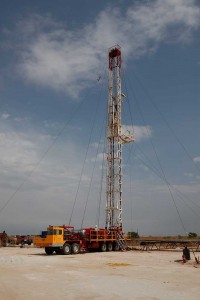By Rebecca Hargus
One might say that well servicing, in contrast to well drilling, is steady. The rig and the work is still there after the excitement and anticipation of drilling has dissipated and the drilling rig has moved on. While the term “well servicing” is usually typified by the workover rig and those who run one, PBOG is taking the term a bit further by including pumpers and well mechanics into the phrase. We spoke with a pumper, a mechanic, workover rig manufacturer, and the classic well servicer to find out what their jobs are like, what new activity is going on in their industry, and what their thoughts are about the recent downturn.
Dex Allred from Rusty’s Well Servicing said that at his workplace, the jobs mostly involve well maintenance. “We mainly work in Martin County and Glasscock County. Things are not quite as corrosive here as they are in the Permian, but leaks always have to be fixed. Anytime there is a drip or anything we get called. We run a crew of about 40. The guys get here around 6:30 or 7:30 in the morning, then they get their jobs. Some do one job some do ten jobs. They get back around 5:00 or 7:00 in the evening.” Every day there is a new problem to fix or a new set of circumstances to work through for the well servicer, it seems.
Allred said, “Right now we have not seen a slowdown, and we are maintaining a pretty good level. We are still busy like we were six months ago—things will probably slow down after we get some projects finished.”
Speaking of slow-downs, PBOG asked Allred how he feels about this recent drop in oil prices. Allred said, “We have been through four of these [downturns]. We [his company] have been around 35 years. I feel confident.”
Contract pumper Ray Clark said that, for him, a typical day starts out at seven o’clock. “I drive about 130 miles round circuit from here to Haskell to Rochester to Rule to Old Glory, back through Sagerton, and then back up to Stamford. I’m checking oil wells on leases, making sure oil is going in the oil tank and the water is going in the water tank.” Said Clark: “My grand-daughter summed it up best. She says, ‘Grandpa, you’ve got a good easy job, you just go out there and you check and you say no leaky, no squeaky!’ I make sure everything is operating and going into the right places, and if there is something wrong, I need to know who to call to get it fixed.”
When asked how he feels about this drastic drop in oil prices, Clark says, “I’m very, very scared [for the economy]. When oil was $100 a barrel, people were ridin’ high. Now it’s gone down to $40 a barrel, and those who haven’t put back money for a rainy day are gonna sink.”
Clark says. “If they [production companies] can get $60 a barrel, they are pretty well covering their a*&.” He added: “C.Y.A. You’ve always gotta C. Y. A. Anything above their breakeven point, they make money, anything below, they lose [so this determines how companies decide when to service a well]. I have a well out there now that really needs to have the downhole pump pulled and replaced, and have another $6,000 pump put down into that hole. Well, it’s gonna be an $18,000 job to do that, and the boss said this morning, ‘Let’s just wait on it.’ If prices were up, the second that thing quit pumping we’d go in there and put a new pump in it.”
PBOG asked all sources if there was anything new going on in the servicing industry, and although the resounding answer was no, Clark did say that the new and ever-increasing regulations are making it harder and harder for work to be done. “It’s not a help, it’s a hindrance. More and more and more rules and regulations… are costing people money that doesn’t have to be spent.”
Drilling has slowed or will slow, and as far as servicing companies are concerned, all PBOG’s sources say the servicing companies feel the economic lag about six months after drilling companies do.
Clark says, “It takes about six months to punch a hole, and get all the production equipment set up… to tell if that hole is going to make any money or not.”
Pieter Bergstein of Standard Energy was also kind enough to speak to PBOG about his industry. The classic well servicing company has a fleet of hot oiler trucks, pump trucks, vacuum trucks, well servicing rigs, and frac’ tanks. Bergstein says that Standard employs about 450 people. He says the company is busy, but they are not doing as many repairs. Bergstein says Standard is compensating for the drop in oil prices and productivity by spending wiser and dropping employees’ average hours to 10 hours a day in order to cut back payroll expenses a little.
Bergstein said, “We look to see what we can do to cut expenses. We look at our expenses and we try to buy smarter—we analyze repairs. When things were booming we didn’t have time to do that [analyze] as much…We used to buy two company pickups a month—we have cut that out.”
Bergstein says one thing Standard is not scrimping on is safety. It seems sometimes employees may get a little lax with things when there is not as much to do. “You would think that in a slowdown accidents are reduced, but actually it is the opposite. We want to make sure we keep their [the employees’] minds to the task. We are keeping spending in safety a priority.”
When asked about new happenings in the industry, Bergstein reports an unfortunate increase in theft. “Rigs are sitting in the field unattended, and things are getting stolen. It is happening all over, not just here.”
Dan Powers of Rig Works Inc. also had a few things to share with PBOG.
Powers said, “I believe the downturn is going to impact the well servicing industry for the next six to 12 months. What I can tell you about Rig Works, currently, is that we have not seen any cancellations on orders pending. We have experienced a downturn in our mast production orders for the second half of 2014.”
PBOG asked Powers what effect the downturn has had on personnel at Rig Works, and Powers responded, “We recently had an increase in personnel in the last two months.”
Powers said Rig Works is not anticipating any personnel cuts, but they have “cut some overtime down. We have been working seven days a week, 10 hours a day for 2014, so this slowdown is going to allow us to really catch our breath.”
When asked why he thinks Rig Works has been so busy, Powers said the rig that Rig Works has manufactured a product with longevity and safety in mind, and that Rig Works has integrated a 116’ tall mast onto a five-axle carrier. He added: “This particular rig/mast combination was designed to be utilized in gas well applications that require high pressure stacks, but also for horizontal, lateral well bores in the Permian Basin, South Texas, and the Bakken, in particular. It is a very versatile, very flexible rig.”
In commenting on the rigs Rig Works produces, Powers said, “This rig/mast design has features that allow the rig to stay on the ground in lieu of utilizing ramps or mud boats for artificial elevation. It’s safer… and it’s more economical because it’s faster to operate and is quicker and less expensive to rig down and rig up than move.”
Powers did comment on a reverse trend in the predominant horsepower range of rigs ordered. “The standard well servicing rig market for decades has been 400-500 series (horsepower) rigs. With the uptick, we saw this drastic market trend recalibration to 500 and 600 series (horsepower) rigs for the last quarter of 2013 to the current time. But with the downturn, I would anticipate a slide backwards to the 400-500 horsepower rigs as opposed to the 500-600. I am expecting our market sector to be a little soft for 6-12 months.”
While it safely can be understood that the economy in the Permian Basin is at best unsteady, conventional wisdom holds that even though things won’t always be booming, things aren’t always going to be slow, either. Those who maintain the status quo through soft markets are the ones poised for a quicker bounceback when the needle turns back up.
Rebecca Hargus is a freelance writer and the editorial assistant for PBOG magazine. She can be reached at rhargus@zacpubs.com.












